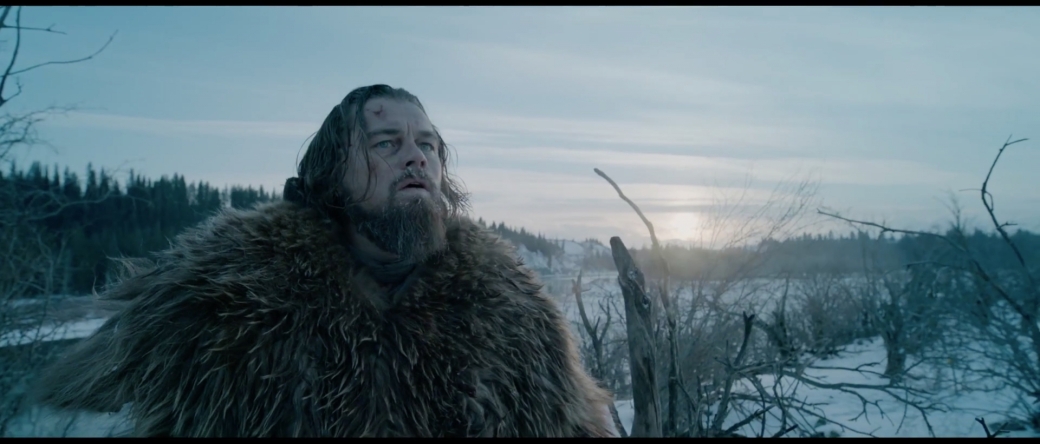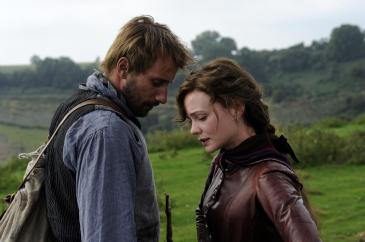Grab a bear-skin and your best spirit of vengeance, its time for my review of The Revenant.

At first glance The Revenant is a pretty standard film about revenge. A man nearly loses his life, and does lose his son, on the edge of the world and then tracks his son’s killer back to the bleeding edge of civilisation through some of the harshest environments possible. The film follows the story of Hugh Glass, played by Leonardo DiCaprio, a trapper, scout and fur-trader in the early eighteen hundreds as the first major push west across America was really taking off. He and his half-native American son guide a party of trappers looking to mine the untouched wilderness for furs and the riches that they can bestow when sold to the masses back east. The tensions within the party, specifically between Tom Hardy’s John Fitzgerald and Glass, are set early and you are quickly assailed by the feeling that this expedition really is eking their existence out of cunning, luck and sheer brutality on the edge of the known world where mistakes mean death. That feeling of everyone’s survival being balanced on a knife-edge lends the film an undertone of desperation from the outset that only grows as it goes on.
Leonardo DiCaprio is being hailed as the frontrunner for this years Best Actor Oscar for his performance in this film, and having seen it I wholeheartedly agree. He inhabits a character that is so far outside of any person I have ever met in his sheer, bone-deep determination, his ferocity and complete devotion to the ideal of “just keep breathing” and it really is something that has to be seen to be believed. I found this especially impressive as I think he has somewhere in the region of about twelve lines in the whole film. The rest of his character is beautifully realised in his physical performance, not just in the horrors that he forces himself to endure, which if tales of the shoot are to be believed were about as real as you can get in the film-making business, but in the way he moves, breathes and watches the world around him. I found myself completely believing that this was a man who had grown up learning to survive in a world that could not care less if he does. The rest of the cast are also on fine form, and without their strong supporting turns I do believe this film would be much less interesting. The three who deserve special mention though are Tom Hardy, who’s portrayal of Fitzgerald as a slimy, self-interested, psychopath is completely believable and utterly chilling. Will Poulter shines as the terrified, but steadfast Jim Bridger, who is one of the few people in the film who starts out with the confidence of his convictions. Seeing his reaction as those convictions are challenged and broken down is truly poignant. Finally Domhall Gleeson shows that, much like in last years Ex Machina but unlike in The Force Awakens, he is completely comfortable playing a multi-layered character. As Andrew Henry, the leader of the trapping expedition he shows the full gamut of emotion from determination to get his men out of trouble, to guilt, to fear, to rage and vengeance with total conviction. Watching these four, as well as the rest of the cast, delve into this brutal world is a difficult but deeply impressive experience.
Something that you should know before going into this movie is that it is not one that shies away from violence. The opening scene of the native attack on the trapper’s camp is something that is unlike any cinematic experience I have had before, as is the bear-attack that comes a little later. I have never watched something that feels so genuinely chaotic and horrific without feeling that the film is showing it on some level to shock the audience. Even in a post-torture-porn world where films such as Hostel have pushed the envelope for the level of violence that an audience will accept on screen, I found this to be different and more powerful than the most gory scenes that Quentin Tarantino or Eli Roth could conjure. This violence is real. It is immediate, vicious and uncaring, much like the world that the characters inhabit. The lack of empathy that the characters feel for one another feels like something from a bygone era, a time where people could not afford to see one another as anything but resources to exploit or obstacles to be removed. It is this more than anything else that makes the violence on show carry more impact than what I am used to seeing in an average action movie. The consequences are permanent and usually fatal, but if not, the scars it leaves run deep and you can feel the trauma that is left behind after the violence itself is ended. This is not a film for the faint of heart.
A lot of this film takes place in the wilderness, and I was really struck by the feeling of a world that is completely untouched by man. The director, Alejandro Gonzalez Inarritu, has done a stunning job of capturing a wild, untamed world that is increasingly difficult to comprehend in the modern, safe, technology-filled place that most of us inhabit. There are a multitude of shots that show characters slogging across vast, snow-covered landscapes that stretch as far as the eye can see. This complete lack of significance in the face of nature was the main thing I took with me from this movie. Nature does not care what the characters in the film are doing, they are mere dots against it’s vastness, their story something minute that carries no weight. But there is the underlying promise that these insignificant men are the vanguard of something that will eventually steam-roll this wilderness into submission. A feeling of the beginning of the end, even as these men fight for survival also runs through the movie like an undercurrent that makes the wide open spaces even more special when you do gasp at their untouched expanses. The contrast between these stark open spaces and the intimate hate that carries Glass through the film is something that I found really stuck with me after I’d left the theatre. That being said, it is not all drudgery and soul-destroying insignificance as the world is shot in such a beautiful way that I regularly found my breath being taken away. Although it may be uncaring of the character’s fates there is something magnetic about the world that surrounds these people. Once the lights came up I found myself not wanting to leave a place that was not only much simpler, but also much more starkly beautiful than the world that most of us inhabit. It would also be a crime if I did not mention the way the camera not only takes in the sweeping vistas of the wilderness but also is not afraid to get right into the thick of the action when it happens. Regularly I found myself feeling breathless or shaky because of the immediacy of what was happening on screen and how it was reflected in the kinetic movement of the camera. This is not to say that everything is filmed in the now somewhat clichéd “shaky hand-cam” that was used to such effect in the Bourne trilogy, rather that the camera itself goes wherever the characters do. Regularly it feels as though you are on horseback or running through the forest, only to be submerged in a raging torrent, being sucked down by the currents and only popping up for brief, life-saving gasps of air as the camera undergoes whatever trial it is that Glass is currently having to endure.
For me the final icing on the cake was the soundtrack, which provided punch and emotion in small, but carefully crafted doses when most needed, but otherwise seemed to be completely made up of the slightly enhanced noises of the wild. Branches creak and crack under the weight of fresh snow. The noise of the snowflakes patting down as they paint the world white. The rough breathing of the characters or some of the beasts they come into contact with. It all combines to make an already immersive experience that much more real. Once I left the cinema I was expecting to find the world outside a little bland, but it was snowing, and the very light pat, pat, pat of the flakes settling took me right back into the movie despite being in a car park in Wolverhampton, which I think is a shining example of how good a job this movie does at putting you into a world that no one has lived in for nearly two hundred years.
All that remains to be said is that this is almost not a film for me, but rather an experience. I cannot recommend enough that you catch this on the biggest screen you can find because seeing it at home will not do the artistry, beauty, brutality and sheer impact of this movie justice.
Rating:
Five Moons out of Five. A masterpiece.





